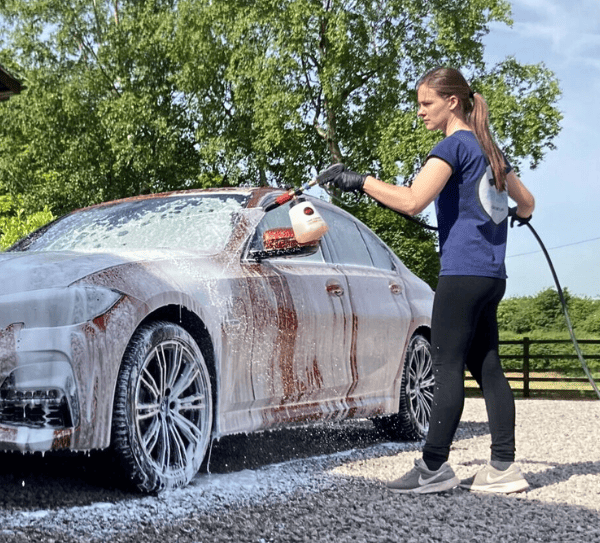Most people don’t realise it, but waxing a new car is as important as waxing a car that’s ten years old, and arguably more important if you really care about your vehicle. In this article, I’ll be talking about why waxing your car is vital if you want to keep it looking newer for longer. So let’s get started!
The Quick Answer
Waxing a brand new car is important to help protect the paint from water spots, dirt and UV rays to keep the finish looking newer for longer. Here are 9 reasons why applying a wax to a new car is necessary.
- Waxes protect the paintwork
- They repel dirt and water
- Waxes help prevent water spot damage
- Makes the car easier to clean
- Prevents contaminants bonding to the paint
- Protects from UV rays and fading
- Shields from minor scratches
- Provides gloss and shine
- Keeps the car looking newer for longer
In this article, I’ll take a look at each of these reasons in a bit more detail. But if you’ve already heard everything you need to know, and you want to crack on and protect your new car, head over to the article below.
Take a look at this complete guide to caring for a brand new car to make sure you’re hitting all the steps.
Protects the Paintwork
The main reason to wax your car, is to keep the paintwork protected. Waxes are forms of paint protection, and they provide an invisible shield over the surface to keep it from getting battered by the elements.
There are three main forms of paint protection: waxes, sealants and ceramic coatings. I won’t go into the specific differences here, but if you’re interested then check out this article on the complete guide to caring for a new car to learn more.
Waxes, sealants and coatings all have the same purpose, to keep the paint protected from dirt, water, the sun, rust, corrosion etc. This is vital if you want the car to look new for years to come.
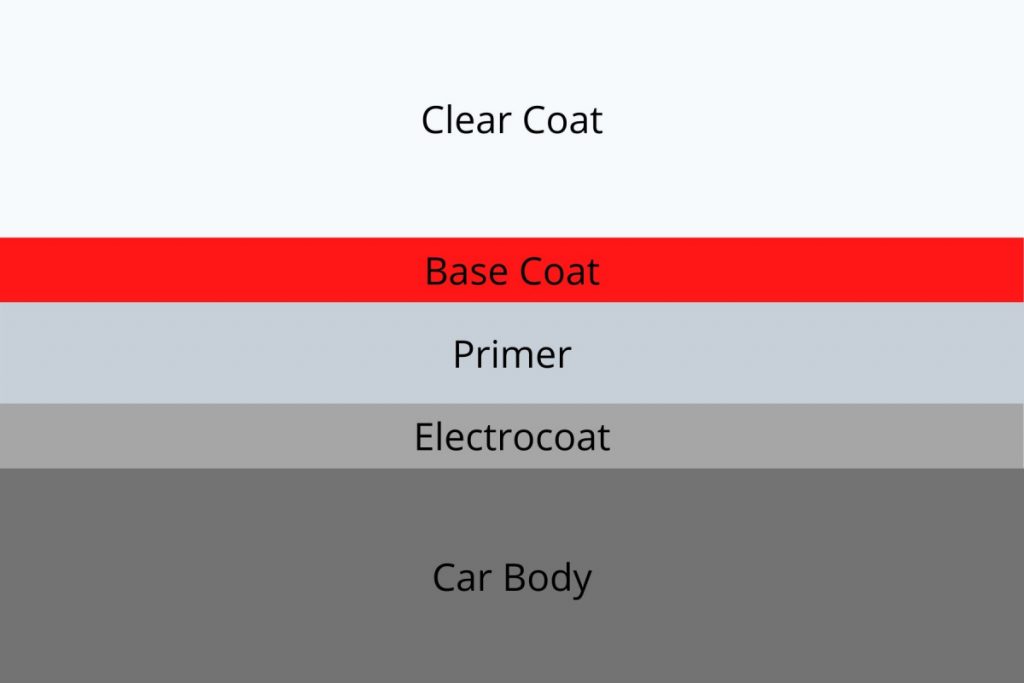
All modern cars have the same paint structure. The two most important layers to consider, are the clear coat and the base coat. The clear coat is invisible and sits on top of the base coat in order to protect it, and the base coat gives your car it’s actual colour.
Without the clear coat, the paint would look super dull and flat, and cause the base coat underneath to fade and rust very quickly leading to a pretty ugly looking finish.
Waxes, (and sealants and ceramic coatings) sit on top of the clear coat in order to help preserve it so it lasts for as long as possible. The result, is a shinier looking finish.
Modern clear coats are designed to last for around 2 years without any washing or waxing. If you don’t look after the paint, then this clear coat will corrode and wear away. However, if you apply a wax, then the clear coat can last for decades.
Now let’s jump into some of the more specific ways that waxes actually protect the paintwork.
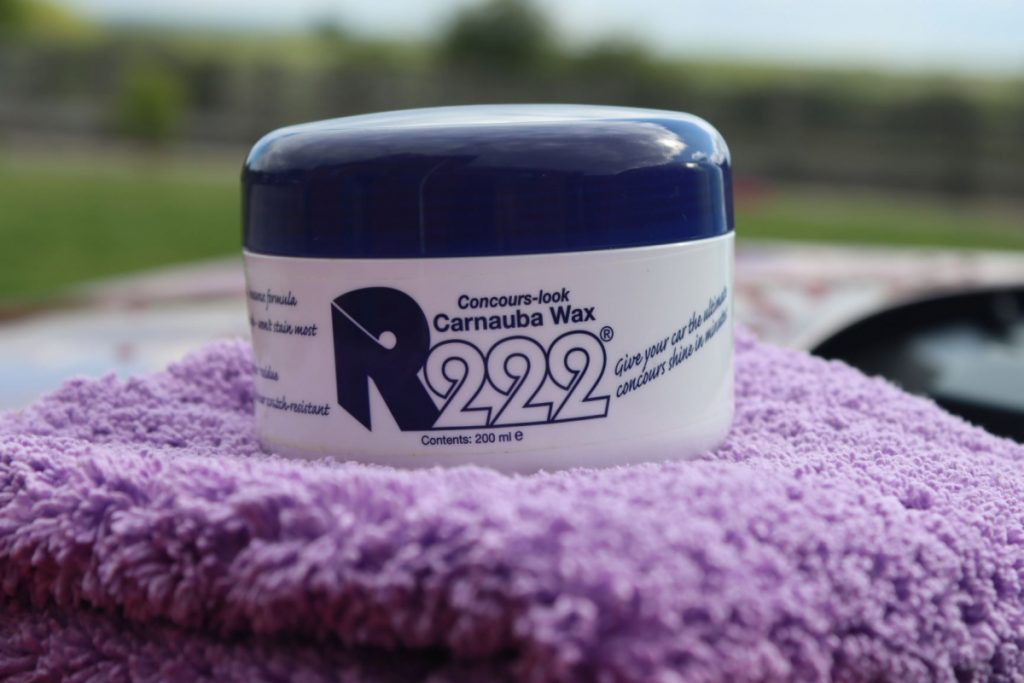
Repels Water and Dirt
This is personally one of my favourite benefits of using a wax. For someone who lives in the UK, where is basically rains 24/7, it’s really important to protect my car from water and dirt, and that’s where waxes come in to it.
Waxes create a hydrophobic layer over the paintwork. This basically just means that it allows it to repel water. Of course, water doesn’t just soak into the paint if you don’t have a wax on it, but it does cause it to spread over the paint and linger for longer. Take a look at these photos to demonstrate.
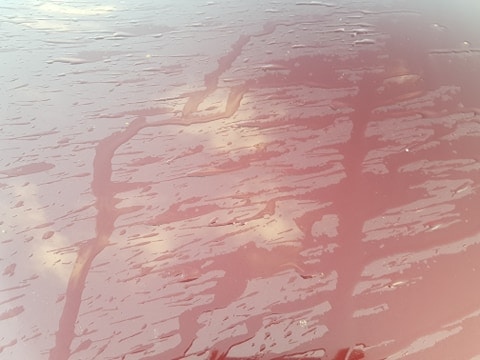
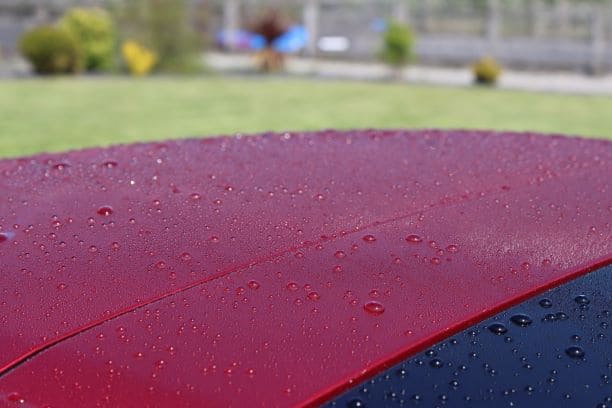
When the car has a layer of wax on the paint, it causes the water to bead or even sheet off the surface. This is really helpful for two reasons.
- It helps to keep the car clean
- It avoids water damage to the paint
This ability of a wax to repel water, also means that it repels dirty water, either from puddles on the road, or rainwater.
When the vehicle doesn’t have any wax, the mucky water tends to stick to the paint and dry, instead of sliding off easily. This essentially makes the car dirtier, particularly if you live in a rainy area.
However, if the car has been waxed, this water tends to simply slide off the paint either when it’s parked up, or when you drive away. The result, is that the car looks cleaner for much longer.
So what about reason number 2? Well, it may seem harmless, but water is actually a pretty big enemy when it comes to protecting the paint. That brings us to the next benefit of waxing a new car.
Prevents Water Spots
Water spots not only look ugly, but they also can actually damage the paintwork. They of course, are caused by water droplets evaporating either after it’s rained, or if you don’t dry your car properly after you’ve washed it. When the water evaporates, it leaves behind a chalky kind of residue, known as a water spot.
These are all the impurities in the water, including minerals and chemicals. These can actually be corrosive to the paint if they’re left to sit on there for a long time. Water spots can actually cause “etching” in the clear coat, which just means that they burn into it and cause it to dip. Take a look at this diagram.
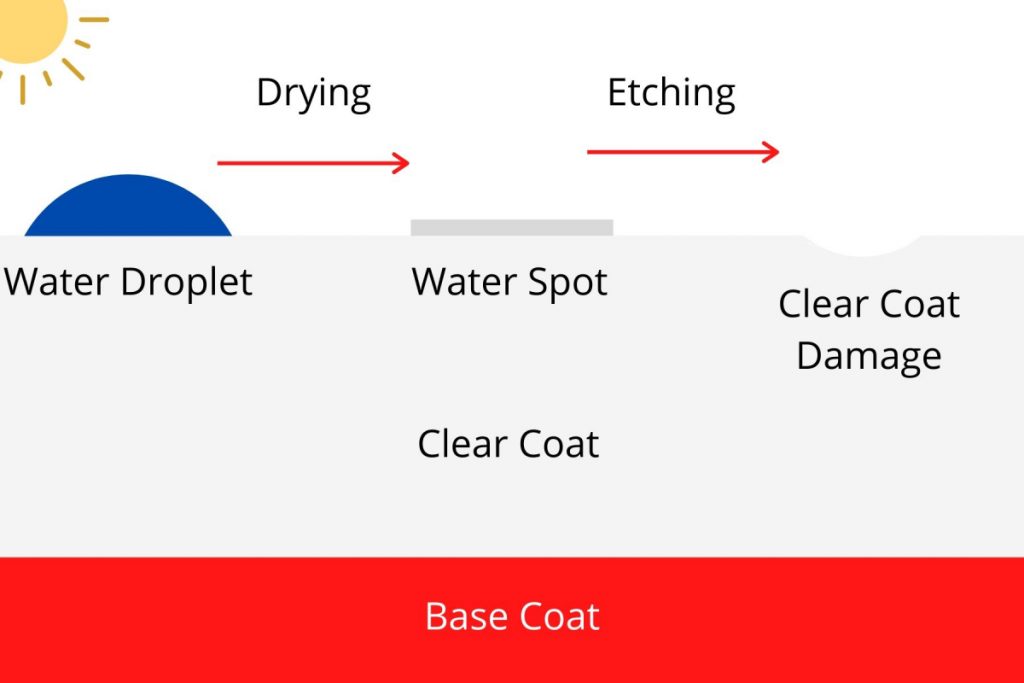
This is a pretty difficult issue to solve, so water spots should be avoided at all costs. The only way to do it, is by avoiding water drying on the car at all.
This means drying it after you’ve washed it by using a soft, clean microfiber towel. But what about when it rains? Well, that’s where waxes really help.
Remember when I said before that waxes cause the water to bead up instead of spread across the paint? This causes it to dry more slowly because the surface area is smaller compared to the volume of water.
This means that when you drive the car, the water will simply fly off the paintwork instead of drying and creating water spots.
It also prevents etching from occurring if any water spots do occur, because the wax will be corroded instead of the actual paintwork.
There are also plenty of other ways to prevent water spots too, so if I’ve panicked you a little, then take a look at my article on the 9 most effective ways to prevent water spots to learn everything you need to know.
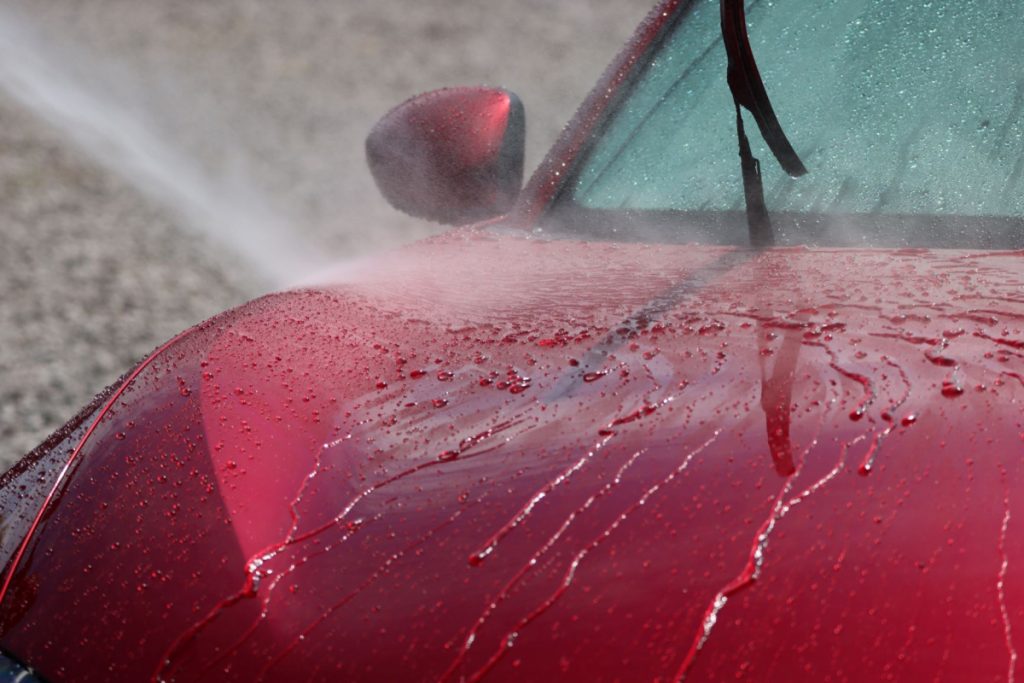
Makes the Car Easier to Clean
Another reason why waxing a brand new vehicle is so important, is because it makes the car a million times more easy to clean. Okay, so that may be a little bit of an exaggeration, but it does make a huge difference.
My car always has a good layer of wax on the paint, and washing it is a breeze. But when I have to clean an un-waxed car, it’s a bit of a nightmare to be honest.
Waxing makes a car easier to clean for the following reasons:
- Dirt and bird poo are removed more easily
- It’s quicker and takes less energy and effort
- It helps reduce the risk of inflicting scratches and swirl marks
Firstly, on an un-waxed car, dirt and bird poo literally cling to the paintwork. However, on waxed cars, the dirt just clings to the wax, and not the actual paint. Since waxes are much slicker feeling, wiping dirt and bird poo off is far easier.
This really helps to reduce the time and effort it takes to clean the car because you can simply wipe all the panels once and know that the paint will be clean, instead of having to keep working on the area.
That leaves us to reason number 3. When dirt doesn’t come off the paint easily, it’s very tempting, and sometimes necessary, to have to scrub at the surface with your wash mitt.
This causes a big issue. Scratches and swirl marks.
The clear coat on your car is actually very delicate, and any kind of friction is likely to cause micro-scratches which cause the finish to look much duller. This occurs whenever you scrub at the paint to try and remove the dirt.
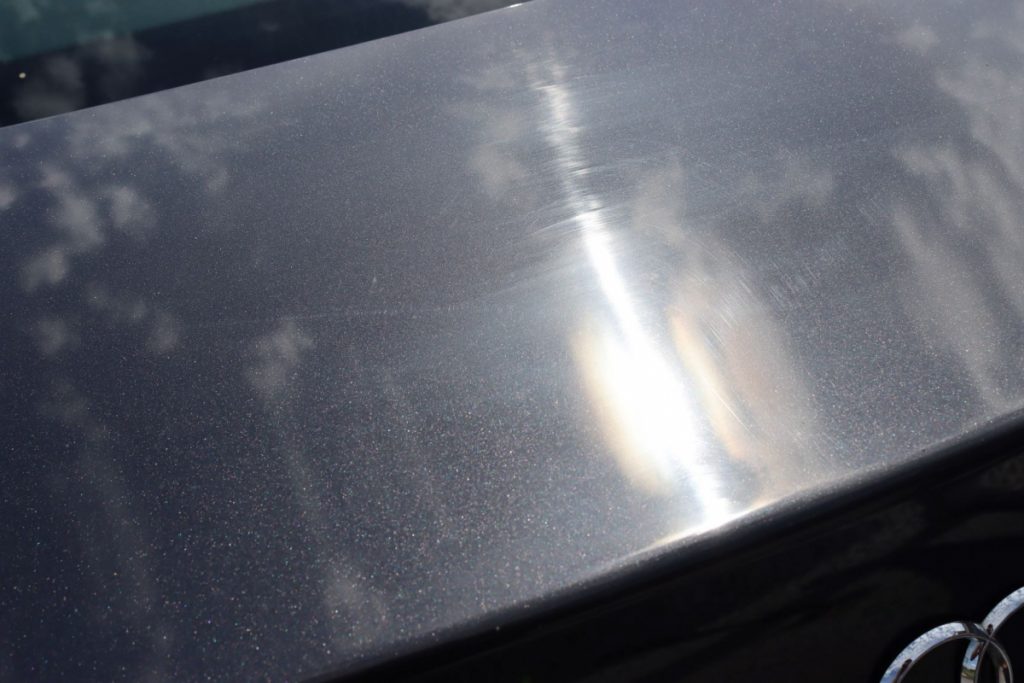
You can really reduce the risk of this by using a good quality wax because you won’t need to scrub at the paint and washing will be much more effortless.
Check out this complete guide to washing your car without causing scratches.
Stops Contaminants Bonding to the Paint
If you’re not that into car care (yet), then you may not know what I mean by “contaminants”, so let me explain what it actually means.
When you wash your car, you are able to remove all the visible dirt on the paint. However, the wash process doesn’t remove everything. It can leave behind “contaminants” which bond to the paintwork and cannot be removed by routine washing.
These contaminants build up over time and cause the paintwork to feel rough. Don’t believe me? Try putting your hand in a plastic sandwich bag and run it over freshly washed and dried paint and you’ll feel the microscopic contaminants on the surface.
They include iron fallout particles, reminiscence of dried bugs, tree sap, water spots and tar. Even new cars suffer from them because they often travel to the dealerships by rail.
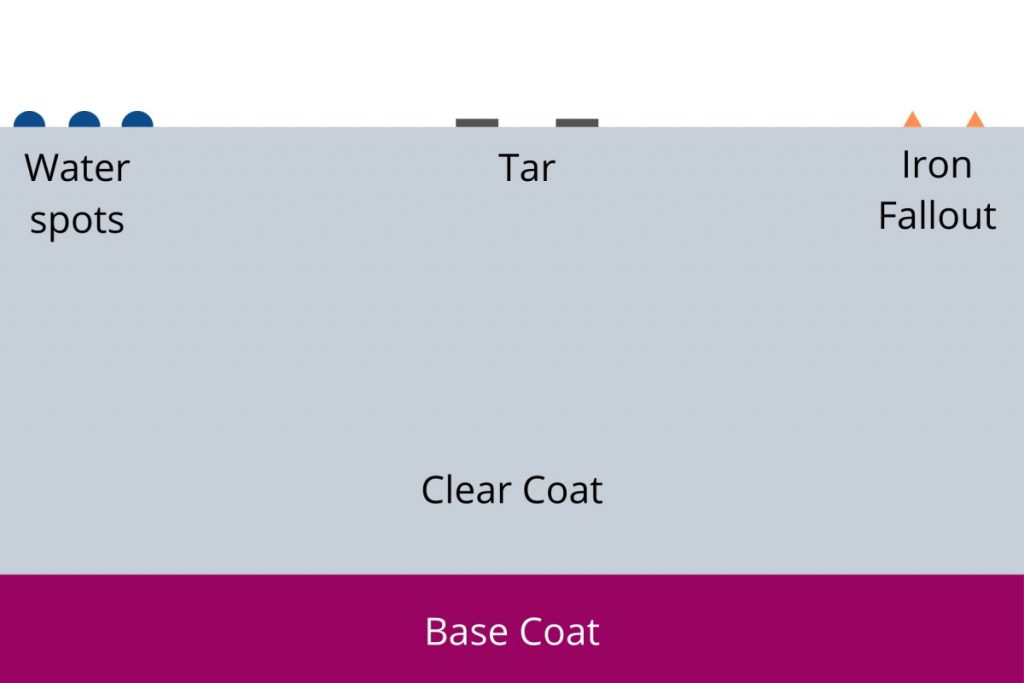
Take a look at this article on why new cars need to be detailed to learn more. Essentially, they cause the paint to wear away over time, look dull and feel rough to the touch.
They can be removed though, using clay bars which essentially shave the contaminants down or pull them off the paintwork completely. Check out this article on clay bars to learn more about them and how they work.
So where do waxes come into this? They actually prevent these contaminants bonding to the paint because they provide an invisible shield of protecting.
Contaminants have a harder time bonding to waxes than paint, and are more easily removed by routine washing. Of course the second benefit is that they stop contaminants bonding to the actual paintwork as well.
They will still build up over time though to some extent, so it’s important to keep checking how rough the paint feels so you know if it’s time to tackle them. However, they will protect the paint and keeping it feeling smooth and looking shiny.
Provides UV Protection
If you live in a sunny climate, then this is a big one. Waxes offer some UV protection to help shield your car’s paint from the sun which can cause severe damage over time.
Waxes sit on top of the clear coat on your car’s paint and provide an invisible shield of protection. This stops the UV rays from penetrating the clear coat to prevent oxidation. Clear coat oxidation causes cracking, peeling and patches to appear in the paint which looks ugly, and exposes the base coat underneath.
Once the base coat is exposed, the car will have a very dull finish and the colour will fade very quickly.
Luckily, waxes preserve this clear coat by taking some of the hit from the sun, leaving the paint underneath more protected.
This of course happens slowly. But if you plan on keeping your car for a few years, then you’ll definitely need to wax it to stop the clear coat essentially wearing away over time.
If you’re worried about sun damage to your car’s paint, then take a look at my article on the 9 essential tips to protect your car from the sun to learn everything you need to know.
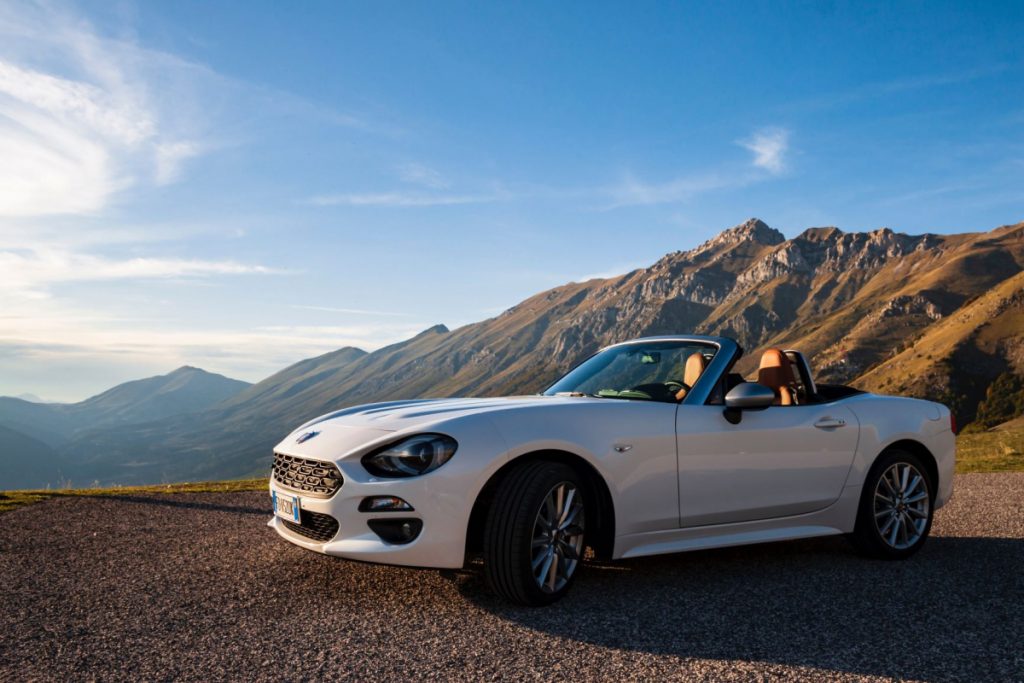
Shields From Scratches
I’ll start off by saying, waxes don’t work miracles when it comes to shielding from scratches, but they do provide some protection and it’s definitely worth mentioning here.
There are several types of scratches you can get on your car. The deepest will penetrate the base coat (colour coat) and even actually hit the metal panels completely. Waxes won’t help to prevent these because they will come from heavy damage such as scrapes and collisions.
But waxes do help to protect again the most common type of scratches, clear coat scratches. These were the ones we talked about earlier, that often occur when washing the car and creating friction. The most common culprit is the sponge. So if you’re still using one, then (please) read this article on how sponges ruin your car’s paintwork.
Clear coat scratches cause the paint to look dull, and are very visible in direct sunlight and often look like swirls or spider webs. Waxes won’t completely protect against poor wash technique, but they can help to minimise the risk and preserve the finish.
But they’re definitely no substitute for washing properly!
Check out this complete guide to washing your car without causing scratches.
Adds Gloss and Shine
Now this is one of the most popular reasons why car owners reach for the wax tin, but it’s definitely lower down on the list for me.
Waxes definitely contain some gloss-enhancing agents like Carnauba which give the car that shiny appearance that everyone wants. But they don’t work miracles.
Shiny paint comes from the actual condition of the paint, not what you put on top of it. The fewer scratches and swirl marks your car’s paint has, the shinier it will be because light reflects more evenly.
Wax can, to some extent, fill these minor imperfections in, but they again, don’t work miracles.
Check out this complete guide to getting glossy paintwork to learn more.
Where I really think that waxes help with making the vehicle look shiny, is by protecting the finish from contamination and keep it cleaner. So in my opinion, it’s more of an indirect effect than simply slapping on some gloss with a wax.
Keeps It Looking Newer for Longer
So this is where things really tie together. Waxes basically just keep your car looking brand new for longer. And isn’t that what every new vehicle owner wants?
If you want to keep that showroom shine, then wax your car as soon as you get it home. It will protect it from the elements, keep it looking glossy, and preserve the finish. You’ll look much cooler driving round in a shiny car than a filthy one.
Plus, when you come to sell the car, the resale value will be higher if you’ve looked after it by applying a wax to keep the paintwork in better condition.
If you want to know which paint protection products I use, then take a look at my recommended products page to find out more!

If you want to learn more about keeping your car looking shiny and new for as long as possible then take a look at this complete guide to caring for a new car.
Thanks for reading! I hope you’ve enjoyed this article. Don’t forget to check out the rest of the website to learn everything you need to know about caring for your brand new vehicle.
Check out the Auto Care HQ YouTube Channel

